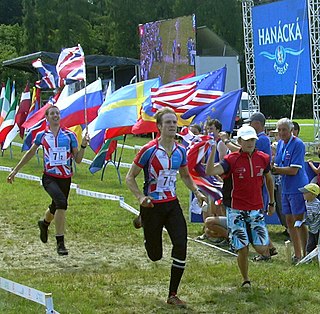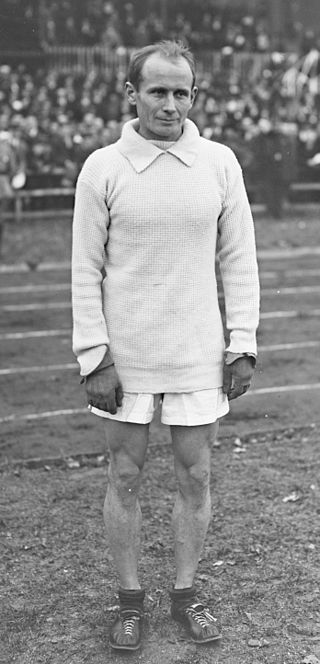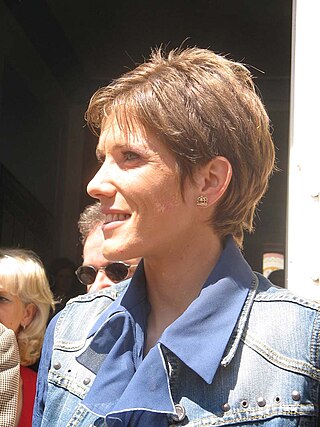Related Research Articles

The marathon is a long-distance foot race with a distance of 42.195 km, usually run as a road race, but the distance can be covered on trail routes. The marathon can be completed by running or with a run/walk strategy. There are also wheelchair divisions. More than 800 marathons are held worldwide each year, with the vast majority of competitors being recreational athletes, as larger marathons can have tens of thousands of participants.
The Olympic flame is a symbol used in the Olympic movement. It is also a symbol of continuity between ancient and modern games. The Olympic flame is lit at Olympia, Greece, several months before the Olympic Games. This ceremony starts the Olympic torch relay, which formally ends with the lighting of the Olympic cauldron during the opening ceremony of the Olympic Games. Through 2022, the flame would continue to burn in the cauldron for the duration of the Games, until it was extinguished during the Olympic closing ceremony. In 2024, electric lighting and mist were used to create a simulated flame for the Olympic cauldron, with the actual flame kept in a lantern exhibited at an adjacent location. That lantern was then taken by French swimmer Léon Marchand from Jardins des Tuileries and ceremonially "transferred" to the Stade de France at the start of the Closing Ceremony: there it was finally extinguished just after the IOC president declared officially closed the Games.

A relay race is a racing competition where members of a team take turns completing parts of racecourse or performing a certain action. Relay races take the form of professional races and amateur games. Relay races are common in running, orienteering, swimming, cross-country skiing, biathlon, or ice skating. In the Olympic Games, there are several types of relay races that are part of track and field, each consisting of a set number of stages (legs), each leg run by different members of a team. The runner finishing one leg is usually required to pass the next runner a stick-like object known as a "baton" while both are running in a marked exchange zone. In most relays, team members cover equal distances: Olympic events for both men and women are the 400-metre and 1,600-metre relays. Some non-Olympic relays are held at distances of 800 m, 3,200 m, and 6,000 m. In the less frequently run medley relays, however, the athletes cover different distances in a prescribed order—as in a sprint medley of 200, 200, 400, 800 metres or a distance medley of 1,200, 400, 800, 1,600 metres.

Juho Pietari "Hannes" Kolehmainen was a Finnish four-time Olympic gold medalist and a world record holder in middle- and long-distance running. He was the first in a generation of great Finnish long-distance runners, often named the "Flying Finns". Kolehmainen competed for a number of years in the United States, wearing the Winged Fist of the Irish American Athletic Club. He also enlisted in the 14th Regiment of the National Guard of New York, and became a U.S. citizen in 1921.

Joan Benoit Samuelson is an American marathon runner who was the first women's Olympic Games marathon champion, winning the gold medal at the 1984 Summer Olympics in Los Angeles. She held the fastest time for an American woman at the Chicago Marathon for 32 years after winning the race in 1985. Her time at the Boston Marathon was the fastest time by an American woman at that race for 28 years. She was inducted into the Maine Women's Hall of Fame in 2000.

Alberto Salazar is an American former track coach and long-distance runner. Born in Cuba, Salazar immigrated to the United States as a child with his family, living in Connecticut and then in Wayland, Massachusetts, where Salazar competed in track and field in high school. Salazar won the New York City Marathon three times in the early 1980s, and won the 1982 Boston Marathon in a race known as the "Duel in the Sun". He set American track records for 5,000 m and 10,000 m in 1982. Salazar was later the head coach of the Nike Oregon Project. He won the IAAF Coaching Achievement Award in 2013.

Paul Kibii Tergat is a Kenyan former professional long distance runner. He became the first Kenyan man to set the world record in the marathon in 2003, with a time of 2:04:55, and is regarded as one of the most accomplished long-distance runners of all time. Runnerworld called him the "Most comprehensive runner of all time".

Tegla Chepkite Loroupe is a Kenyan long-distance track and road runner. She is also a global spokeswoman for peace, women's rights and education. Loroupe holds the world records for 25 and 30 kilometers and previously held the world marathon record. She was the first African woman to hold the marathon World Record, which she held from 19 April 1998 until 30 September 2001. She is the three-time World Half-Marathon champion. Loroupe was also the first woman from Africa to win the New York City Marathon, which she has won twice. She has won marathons in London, Rotterdam, Hong Kong, Berlin and Rome.

Shambel Abebe Bikila was an Ethiopian marathon runner who was a back-to-back Olympic marathon champion. He was the first Ethiopian Olympic gold medalist, winning his first gold medal at the 1960 Summer Olympics in Rome while running barefoot. At the 1964 Tokyo Olympics, he won his second gold medal, making him the first athlete to successfully defend an Olympic marathon title. In both victories, he ran in world record time.

Catherine Nyambura Ndereba is a retired Kenyan marathon runner. Between 2003 and 2008, she finished in the top two in five successive global championship marathons. Ndereba has twice won the marathon at the World Championships in Athletics and won silver medals at the Summer Olympic Games in 2004 and 2008, becoming Kenya's first female multi-medalist. She is also a four-time winner of the Boston Marathon and a two-time winner of the Chicago Marathon. It was at the latter in 2001 that she broke the women's marathon world record with a time of 2:18:47.

Vanderlei Cordeiro de Lima is a Brazilian retired long-distance runner. He was born in Cruzeiro do Oeste, Paraná. While leading the marathon after 35 km (22 mi) at the 2004 Summer Olympics, he was attacked on the course by Irish former priest Cornelius "Neil" Horan. Following the incident, Lima fell from first to third place, eventually winning the bronze medal. He was later awarded the Pierre de Coubertin Medal for his sportsmanship shown in that race.

Francois Robert "Rob" de Castella is an Australian former world champion marathon runner.
Fred Lebow, born Fischel Lebowitz, was a Holocaust survivor, runner, race director, and founder of the New York City Marathon. Born in Arad, Romania, he presided over the transformation of the race from one with 55 finishers in 1970 to one of the largest marathons in the world with more than 52,000 finishers in 2018. He was posthumously inducted into the National Distance Running Hall of Fame in 2001.

The Mumbai Marathon, is an annual international marathon held in Mumbai, India, on the third Sunday of January every year. It is the largest marathon in Asia as well as the largest mass participation sporting event on the continent. It is the richest race in India with a prize pool of US$405000.
Ellison Myers Brown, widely known as Tarzan Brown, a direct descendant of the last acknowledged royal family of the Narragansett Tribe of Rhode Island, was a two-time winner of the Boston Marathon in 1936 (2:33:40) and 1939 (2:28:51) and 1936 U.S. Olympian. He ran the marathon in the 1936 Summer Olympics in Berlin and also qualified for the 1940 Summer Olympics, which were ultimately canceled due to the outbreak of World War II.

Ted Corbitt was an American long-distance runner. The first African-American to run the marathon at the Summer Olympics and the founding president of New York Road Runners, Corbitt is often called "the father of American long distance running." He was also an ultramarathon pioneer, helping to revive interest in the sport in the United States in the 1960s and 1970s. New York Times columnist Robert Lipsyte called Corbitt a "spiritual elder of the modern running clan". In a Runner's World feature honoring lifetime achievement, writer Gail Kislevitz called Corbitt a "symbol of durability and longevity". Corbitt was among the first five runners to be inducted into the National Distance Running Hall of Fame, and the first to be inducted into the American Ultrarunning Hall of Fame.

Olivera Jevtić is a Serbian long-distance runner. She has represented her country five times at the Olympics in 2000, 2004, 2008, 2012 and 2016.

Kara Goucher is an American long-distance runner. She was the 10,000 meters silver medalist at the 2007 World Championships in Athletics and represented the USA at the 2008 Beijing Olympics and 2012 London Olympics. She made her marathon debut in 2008 and finished third the following year at the Boston Marathon.
Amy Palmiero-Winters is a below-knee amputee, long-distance runner, and triathlete. She holds eleven world records in various events. In 2010, she was awarded the James E. Sullivan Award as the top amateur athlete in the United States and the ESPN ESPY Award as the top female athlete with a disability in the world.
Roy Dooney is an Irish former runner, who came second at the 1991 Chicago Marathon. He won the 1992 Grandma's Marathon, and was a member of the Irish team that won the 1988 New York City road relay race.
References
- 1 2 " The Neediest Cases; Immigrant Has Medals for Running, and Ambition for Wider Success" by Stephanie Rosenblaum, The New York Times , November 3, 2004
- ↑ articles.nydailynews.com
- ↑ Image caption: "Torchbearer Boubacar Traore carries the Olympic Flame onto the grounds of the United Nations during Day 15 of the ATHENS 2004 Olympic Torch Relay on June 19, 2004 in New York City.", Getty Images
- 1 2 "Robin Hood Honors Four New York City Heroes" Archived August 5, 2007, at the Wayback Machine , press release, December 12, 2006
- ↑ Boubacar Traore race results Archived September 27, 2007, at the Wayback Machine , athlinks.com
- ↑ Andy Romanelli" [ permanent dead link ], achillestrackclub.net